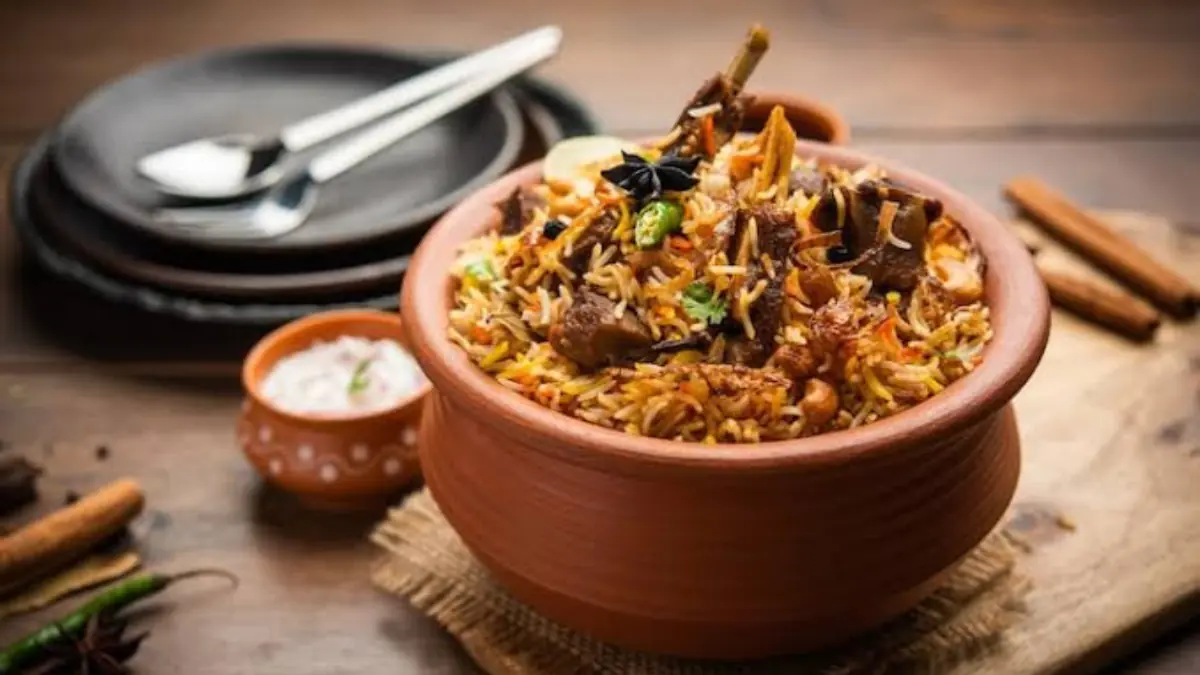Kacchi Gosht Ki Biryani is a celebrated dish in Hyderabadi cuisine, known for its unique technique of layering raw marinated meat at the bottom of the pot, topping it with partially cooked basmati rice, and then slow-cooking the whole dish on dum (sealed steam cooking). Unlike pakki biryani, where the meat is cooked separately, this method allows the meat to release its juices into the rice, infusing every grain with flavour.
The meat, usually mutton, is marinated with a mixture of yoghurt, fried onions, ginger-garlic paste, chilli powder, turmeric, and a blend of ground spices. Saffron milk, fresh herbs, and whole spices like cardamom, cinnamon, and cloves give the biryani its characteristic aroma. The slow cooking process tenderises the meat while keeping the rice fluffy and separate.
Nutritionally, this dish is a good source of protein from the meat, carbohydrates from the rice, and healthy fats from ghee. The spices also contribute antioxidants and aid digestion. Traditionally serv
Kacchi Gosht Ki Biryani is a celebrated dish in Hyderabadi cuisine, known for its unique technique of layering raw marinated meat at the bottom of the pot, topping it with partially cooked basmati rice, and then slow-cooking the whole dish on dum (sealed steam cooking). Unlike pakki biryani, where the meat is cooked separately, this method allows the meat to release its juices into the rice, infusing every grain with flavour.
The meat, usually mutton, is marinated with a mixture of yoghurt, fried onions, ginger-garlic paste, chilli powder, turmeric, and a blend of ground spices. Saffron milk, fresh herbs, and whole spices like cardamom, cinnamon, and cloves give the biryani its characteristic aroma. The slow cooking process tenderises the meat while keeping the rice fluffy and separate.
Nutritionally, this dish is a good source of protein from the meat, carbohydrates from the rice, and healthy fats from ghee. The spices also contribute antioxidants and aid digestion. Traditionally served during weddings, Eid celebrations, and family gatherings, it is a complete meal on its own, often accompanied by raita, salan, or a fresh salad.
To make it, the marinated mutton is placed in the cooking vessel, topped with parboiled rice, then layered with fried onions, herbs, saffron milk, and ghee. The pot is sealed, usually with dough, and placed over low heat so the meat cooks in its own juices while the rice steams to perfection. This technique requires patience and careful heat control but rewards you with tender meat and perfectly aromatic rice in every bite.
The flavour improves when the biryani is allowed to rest for a few minutes after cooking, as this helps the rice absorb the last of the steam and settle. While it may seem elaborate, this recipe is achievable at home with the right preparation and yields a biryani that tastes restaurant-quality.








